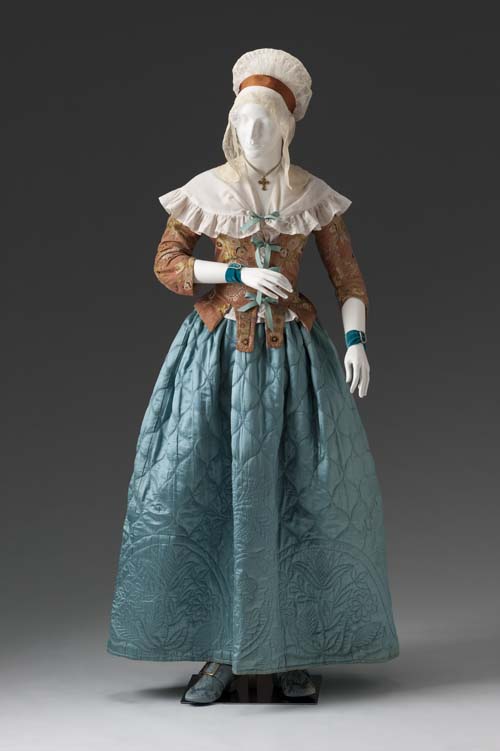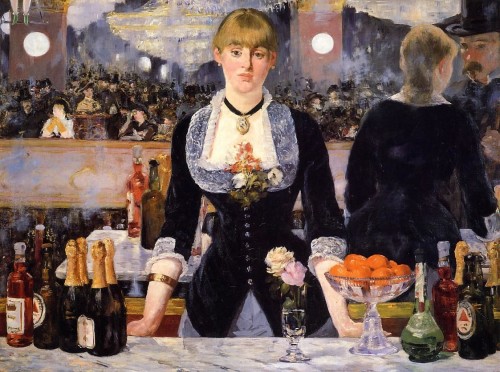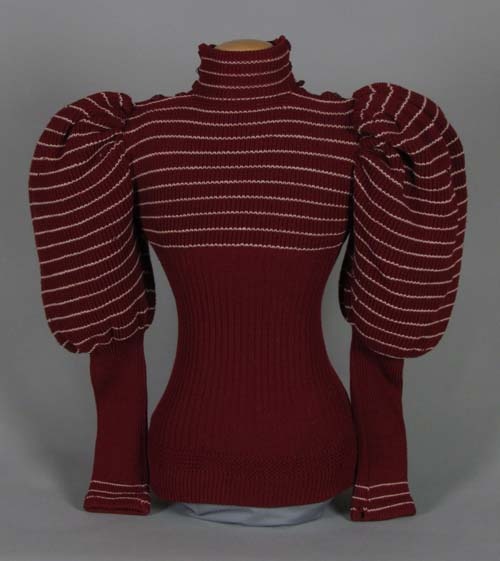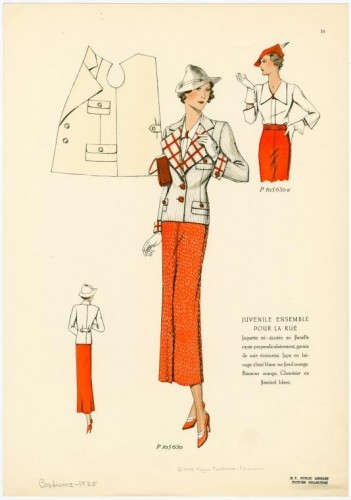Working in museums, one of the things we often talk about is the disparity in what ends up in a museum costume collection compared to what people actually wear. Collections are full of wedding gowns and ballgowns: memories of the grandest moments of our lives. On a day to day basis though, people wear much simpler clothes: practical, interchangeable items. Today this is jeans and t-shirts, but throughout history even the wealthiest have worn simple separates for the less momentous occasions.
The Historical Sew Fortnightly Challenge #16 is all about Separates: items that can be paired with other pieces in your wardrobe to extend a look.
My favourite anecdote about separates involves Queen Victoria and her future daughter-in-law Alexandra. On being introduced the Alexandra, the Queen noticed that she wore a skirt with one jacket one day, and the same skirt, with a different jacket, the next day. Victoria was delighted. To her, this indicated a frugal and practical nature: just the thing to balance the son that she and Albert had viewed as overly frivolous and wayward. As it happened, Alexandra’s practicality in dress was just a sign or her family’s poverty. Rather than stabilizing Edward, the Crown Prince, denied any real responsibility even after his marriage, became ever more frivolous and decadent, and Alexandra, abandoned as a wife, turned to fashion to distract herself, and could rarely be accused of frugality and practicality in dress in later decades. Still, I love the idea of Queen Victoria being wooed by a little practical dress!
Here are a few of my favourite historical separates to get you inspired:
Gerard Ter Borch’s Dutch genre paintings of the mid 17th century are full of beautiful separates, with skirts and bodice paired in different combinations from painting to painting. I particularly love this rose red bodice and the white satin skirt it is paired with:

Gerard ter Borch (1617—1681), The Concert, 1655, Gemäldegalerie
And, of course, we all adore the pretty chocolatier and her charmingly un-matched jacket and skirt:

Jean-Étienne Liotard (1702—1789), La Belle Chocolatière (The Chocolate Girl), 1743 until 1745
The later 18th century is a fantastic time for separates, and the ultimate might be the quilted petticoat, which, based on paintings, could be paired with just about anything, in this case, a caracao jacket:

Caraco circa 1780, quilted Petticoat circa 1770-1780, Mint Museum
Regency menswear is all about mixing and matching, with the 3 piece coordinating suit of the 18th century abandoned in favour of unmatched breeches, waistcoat and jacket:

Journal des Dames et des Modes, 1801
I adore 1860s separates: the blouses and skirts are the earliest inklings of our modern T-shirts and jeans wardrobe.

Circa 1863, via US National Archives
The 19th century counterpart of Liotard’s La Belle Chocolatier is obviously Manet’s Suson at the Folies-Bergère. I’ve made one version of this outfit, and while I’m still happy with it, I’ve learned a lot since I made it, and would love to have another go at her black jacket and steel blue skirt – and perhaps another skirt to go with it!

A Bar at the Folies-Bergère, Edouard Manet, 1882
Going back to the idea of T-shirts, the 1890s saw the introduction of knit tops. I want to learn to knit just so I can make something like this:

Burgundy wool sweater, mid-1890s. DAR
This 1930s outfit is a full ensemble, but it would be so easy to pair the individual pieces with different items, and so practical in the midst of the Great Depression.

Juvenile ensemble pour la rue. 1935
And that’s really what this challenge is all about: practicality. Extend your historical wardrobe with an item that turns something you have into a second outfit, which is exactly what our forbearers would have done, whether they were peasants to princesses.

This is an excellent challenge! I love practicality and frugality (have to, but do).
This is an excellent challenge! I love practicality and frugality (have to, but do). I wonder, how would this work for earlier eras?
I think this should be pretty easy for earlier eras – just make a different pair of sleeves to go with your medieval gown, or a different under or over-gown, for men, you get a new tunic or hose. I could make an alternate pallas to wear with my stola, or stola to wear with my pallas, etc. etc.
“Internal server error” for the win… double post. *sigh*
Did you know that even after her marriage, Alexandra still had her wedding dress completely and totally made over? The dress still exists, but has been almost completely stripped of its lace and shows signs of having been remodelled and altered.
Yep! Victoria did a similar thing. 19th century wedding dresses were just evening gowns in the broader sense – you just keep wearing them. And lace is like jewellery, it moves from frock to frock.
Yay! I am jumping for joy!
I’m working on a pattern for a pierrot jacket and have been searching for a way to work it into the challenge.
Now I have a way to include it, thank you!
This challenge is awesome.
I also love that “I like them, and a jacket is so economical” story.
In the 1860s and 1870s, it was common to find collections of matching pieces to create different outfits for different occasions. One of the commonest was a skirt with two different bodices; one was usually an evening bodice while the other could be a day or afternoon bodice. Back when I was sewing costumes for LARPs set in that period, I was pleased that it was actually period to do things that way, instead of just a way to do less sewing!
Good point, though I actually carefully avoided mentioning those, because they aren’t really separates (not that I’ll disqualify anyone for making an extra matching bodice for an 1860s gown!) – they are matching components to one outfit.
Fair point. More precisely, they’re a coordinated wardrobe, but that is somewhat different from the separates idea.
I love the quilting on the turquoise skirt!
I’ve been meaning to expand my Victorian wardrobe for this very reason for many a year. I swear I’m going to complete more than one challenge this year!
I’m still clucking happily to think that you are thinking of making a quilted petticoat! Now you tell me it will go with anything! Extra reason to make one.
Loved this post!
I do believe I’ve never, in my life, seen anything as wonderfully beautiful and absurd as that glorious knitted leg of mutton sleeved sweater! There really aren’t words to describe my feelings for this sweater, except wild, envious love of it.
Thanks for the inspiration. =]
I’m always looking for more ways to wear my clothes. I get stuck in a rut of wearing the same things together all the time. Lately, I’ve been trying to branch out a little. =] What perfect pictures to inspire!
Love the 1860’s picture! It is such a rarity to find a portrait where the subject is… well, smiling for one.. and wearing a WHITE blouse and her ears are uncovered and she doesn’t have a middle part. I think she must be a kindred spirit. =]
I think I just died from looking at that caracao & quilted petticoat.
I’ve just posted about my separate item for the challenge: a straw hat from 1857.
http://quinnmburgess.wordpress.com/2013/07/24/hsf-16-eugenie-inspired-1857-straw-hat/
Best,
Quinn
[…] plus de ce corset, j’ai bien envie de participer au prochain challenge Historical Sew Fortnightly pour la semaine prochaine avec une sous-jupe de robe 1880. Cela fait un moment que j’envisage […]
[WORDPRESS HASHCASH] The comment’s server IP (66.155.9.38) doesn’t match the comment’s URL host IP (76.74.254.120) and so is spam.
My entry for this challenge is rather plain…an 18th century petticoat. http://livingwithjane.blogspot.com/2013/08/historical-sew-fortnightly-challenge-16.html
I made a blouse, as a home for some lace I made ages ago.
http://blacktulipsewing.blogspot.co.uk/2013/08/separates.html
[…] aussi commence ma jupe de dessous pour le challenge Separate de the Dreamstress, mais ce n’est pas encore assez avance pour vous le […]
[WORDPRESS HASHCASH] The comment’s server IP (72.232.114.10) doesn’t match the comment’s URL host IP (72.233.2.58) and so is spam.
Done!
http://isabelladangelo.blogspot.com/2013/08/historical-fortnightly-challenge-16.html
I created a high neck smock for cooler events.
I had intended to make a pierrot. But I realized that, being part of a matchy outfit, it did not qualify.
Instead I made a flea-coloured version of the Kyoto Costume Institute’s drawstring jacket.
http://mouseborgdesigns.blogspot.ca/2013/08/the-kci-drawstring-jacket-is-done.html
I’m a couple weeks late, but I made a little 18th century jacket for challenge 16.
Caroline
http://dressedintime.blogspot.com/2013/08/hsf-16-separates-ok-so-its-two-weeks.html?m=0
I’m also very late, but here is my first venture into the 18th century (more on the inspired than accurate side though):
http://caddamsbetraktelser.wordpress.com/2013/09/04/hsf-16-separates-that-1700s-show/
I sewed a colonial shirt with ruffles for my son.
http://teacupsamongthefabric.blogspot.com/2013/08/a-new-18th-century-shirt-for-my-son.html
Laurie
I have moved my blog. My 18th century men’s shirt can be found here: http://teacupsinthegarden.blogspot.com/2013/08/a-new-18th-century-shirt-for-my-son.html